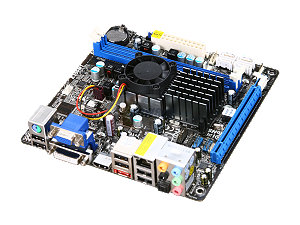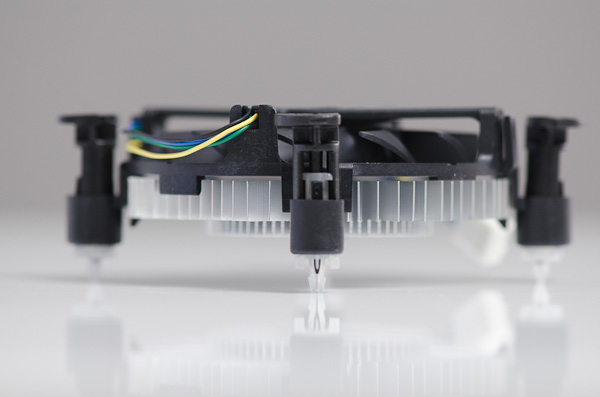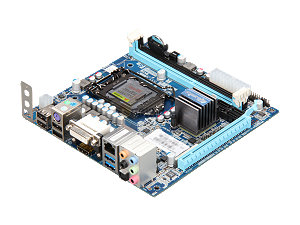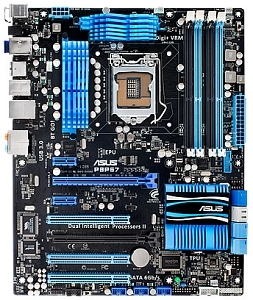File Server Builder's Guide
by Zach Throckmorton on September 4, 2011 3:30 PM ESTCPUs
Once again, the primary purpose of a file server is storage. It is not computation prowess nor producing high frame rates in games. All other components, including the CPU, should take a back seat to the hard drives, case, and power supply in the context of a home file server. File servers do not - repeat, do not - need the latest, greatest, more powerful processors to work well. In fact, file serving is not a particularly taxing task, especially not for a home file server that will likely never have to distribute data to more than a handful of clients simultaneously. Therefore, rather than using a powerful and power-hungry CPU, it's a better idea to use a less capable but also less power consuming chip.
From A(tom) to Z(acate)
Intel's Oak Trail (using Atom CPUs) and AMD's Brazos (using Zacate APUs) platforms are both up to the task of file serving. However, neither platform produces a particularly pleasant experience with Windows Home Server 2011. Both platforms take an agonizingly long time to install WHS2011, and neither will be capable of doing much more than simply serving - transcoding video on an Atom or Zacate WHS2011 system is painfully slow. That said, both Oak Trail and Brazos are sufficient to run WHS2011, especially if your file server will be performing only basic tasks like streaming MP3s and storing photos.

My preferred Atom home server motherboard/cpu combo is the ASUS AT5NM10T-I, a passively-cooled, Atom D525 (1.8GHz dual core with Hyper-Threading) solution that sports four SATA ports (rather than the two found on most Intel boards) and a PCIe x4 slot. The PCIe expansion slot is useful for adding a SATA controller card in case you want your file server to house more than four drives. Note it uses laptop SODIMMs rather than standard desktop DIMMs but considering how inexpensive DDR3 is currently, this does not affect the system's cost. One thing to keep in mind when selecting an Atom-based file server: go for the most recent models that are dual cores and have Hyper-Threading - the price premium is very modest and the performance increase is palpable.

ASRock's E350M1 is a more fully-featured Zacate motherboard that includes the E-350 APU (1.6GHz dual core), four SATA ports, an eSATA port (useful for backups), as well as VGA, DVI, and HDMI out ports. While multiple display outputs might not be an important consideration for a file server, more flexibility is always better. At just under $100 through Newegg currently, it is an exceptional value. Its expandability is limited to one PCIe x16 slot, which can also accommodate PCIe x4 and x1 cards - whereas PCIe 'up-plugging' can be hit or miss on different motherboards, I have had excellent success up-plugging on this particular model.
In comparing Atom with Zacate in the context of a file server, the regular laptop or desktop experience paints a useful picture. Atom is barely sufficient. Zacate is sufficient. Zacate's main strength is its integrated GPU, which is not particularly useful for a file server, but its CPU prowess is also substantially better than Atom's. While the Atom CPU officially draws less power on paper (with a TDP of 13W) than than the E-350 APU (at 18W), in practice, the two platforms consume very similar amounts of power both at idle and under loads typical of a file server (which do not tax the E-350's integrated GPU). Given that these platforms are priced similarly, use similar quantities of electricity, and the AMD platform's greater general flexibility, it is difficult to recommend the Atom-based solution given Zacate's substantial performance advantage.
The Sandy Bridge Pentiums
Anand recently reviewed the Sandy Bridge-based Pentiums, some of which have been available now for a few months. These CPUs are excellent home file server processors: they have enough muscle to smoothly run WHS2011 and produce a very pleasant computing experience, they use little power under load, and they are not expensive. The Intel Pentium G620 has become my go-to file server CPU since its release back in Q2. It is the least expensive Sandy Bridge desktop CPU at less than $80, and though its TDP is 65W on paper, in reality, it uses far less power under real world load. It uses even less power than its more powerful yet still juice-sipping Core i3-2100 cousin, and this combination of using not much electricity while being powerful makes it difficult to recommend any AMD CPU that is comparably priced. Unless you are on an extremely tight budget, a G620 makes more sense for a file server than, say, the AMD Athlon II X2 250. You can get an idea of how the G620 and 250 compare by looking at Bench - though since Bench doesn't include the 250, we're using the 255, which is ever so slightly faster than the 250. Pay particular attention to the power usage levels: at idle, the G620 system uses over 20W less than the 250 system, and uses less than 50W less under load.
But what about the lowly, dirt cheap Sempron 145? Its TDP is only 45W and though it's a single core CPU, it's still powerful enough for a file server, even one running WHS2011. Again, though, there's a difference between official TDPs and real world TDPs: my own testing shows that the Sempron 145 also idles nearly 20W higher than the G620. So the same conclusion immediately above also applies: unless you are on an extreme budget, you're better off with the G620 than the 145. These increases in CPU power consumption by the AMD CPUs compared to the Sandy Bridge Pentium translate directly into heat dissipated into your file server's case. Whether this is enough heat to make a difference depends on your case and cooling solutions - but in my experience, it's enough to push hard drive temperatures from the high 30s (Celsius) to to the mid 40s Celsius in especially small cases.
Though power consumption factors prominently in our recommendation of the Pentium G620 over the Athlon II X2 250, it's important to not lose sight of the forest for the trees: a 20W difference in power consumption for a file server CPU is the rough equivalent of leaving a smaller, lower wattage incandescent light bulb like a reading lamp on 24/7 in your home. Ultimately, the decision is simple: is a $25 or more premium for the G620 worth saving 20W+ on your electrical bill over the long haul?

The lilliputian Intel Pentium G620 heatsink and fan is a good indication of the chip's heat output
Motherboards
Whether you use a mini-ITX, micro-ATX, or full-size ATX motherboard will largely be dictated by the size of the case you decide to house your home file server in.
Mini-ITX

Mini-ITX boards sacrifice expandability for small size. Few ITX motherboards have more than four SATA ports, limiting them to use in file servers that will hold maximally 12TB (the largest commercially available hard drives are 3TB). However, most ITX motherboards have at least one expansion slot, which can hold a SATA controller card. There are many LGA 1155 motherboards that are compatible with the Intel Pentium G620, and most have very similar feature sets. However, in a mini-ITX case, board layout becomes critically important. My favorite ITX 1155 motherboard is Giada's MI-H61-01 specifically because its four SATA ports are clustered on the lower right aspect of the board (when it's mounted), right by the front panel connectors and 20 pin ATX power port. Because the four pin CPU power connector is located on the upper left corner, cable management is a breeze and facilitates excellent airflow - everything goes to either the lower right or upper left corners, allowing cables to be run along the top or bottom of the mini-ITX case. The Giada MI-H67-01 has a nearly identical layout and is sometimes less expensive than the H61 board. Though Giada is a newcomer to the North American market and do not have the reputation of older brands like ASUS, for what's it worth, I have used many of these boards in both file server and regular ITX desktop builds and have been completely satisfied by their products. Remember, if you want to build a mini-ITX file server that will have six hard drives, you will need to buy a PCIe SATA controller card with two SATA ports like the SYBA SD-SA2PEX-2IR or Rosewill RC-211.
Micro-ATX
Micro-ATX LGA 1155 boards can sport up to seven total SATA ports (4 SATA II and 3 SATA III), but most come with four or six total SATA ports. As with mini-ITX file server boards, layout is important when stuffing many hard drives into a micro-ATX case. The Biostar TH67B places all six of its SATA ports at the very bottom right-most corner of the board. Unfortunately there are no micro-ATX 1155 options that push the 20+4 pin power connector to either the very top or bottom of the board, but at least this Biostar board has its four pin power connector at the very top.
Full ATX

Cable management is rarely as difficult in a full-size ATX case as it can be in micro-ATX and mini-ITX cases, so board layout is perhaps less important for a full ATX file server motherboard, but it is still a consideration. Ten hard drives can become very messy! ATX 1155 boards max out at 10 ports, however, ten SATA port boards are typically $200 or more, whereas eight SATA port boards like the ASUS P8P67 can be found for as little as $125. Thus, if you absolutely need ten HDDs in your file server, it makes more sense to spend $125 on the board and $25 on a two port SATA controller card than $200 on a ten SATA port motherboard. I like this ASUS board for multiple HDD systems because its SATA ports are mounted perpendicularly to the board facing forward and at about the same height as one PCIe x1 and one PCI slot, so managing the SATA cables facilitates better airflow than if they were coming off of different heights on the board.
RAM
File servers do not need high performance, low latency, high frequency RAM. FreeBSD, FreeNAS, and Ubuntu all run well with 2GB of RAM under loads typical of a home file server, but they do run palpably smoother with 4GB. WHS2011 runs much more smoothly with 4GB. All of the file server OS's run even better with 8GB RAM. As RAM prices continue to fall, 8GB kits have been available for less than $30 (after rebate) regularly. Because RAM prices are so dynamic lately, rather than recommending a specific product, we'll recommend that you shop around! You should be able to find 2GB, 4GB, or 8GB for $5/GB without a rebate or less than $5/GB after rebate.
Now that we've covered CPUs, motherboards, and RAM, the next page discusses cases and PSUs solutions.










152 Comments
View All Comments
praeses - Monday, September 5, 2011 - link
I'm doubtful it is the most widely used platform for home users, but it does offer some pretty attractive features such as spinning down individual drives in the array, mix and match sizes, and isolated data loss with multiple drive failures. It seems like a better "drobo" and its not necessarily just a NAS as this article is trying to distinguish from.nevertell - Monday, September 5, 2011 - link
I wouldn't use any cpu that isn't able to transcode 1080p streams, as that would be the best use of such a box. If I use a ps3 to watch movies, I can setup a mediaserver on the box so every media file is available for every device in my network. While you can get ffmpeg to be used as a transcoder, the formats you can transcode using a gpu are limited.Rookie_MIB - Monday, September 5, 2011 - link
Running two file servers at home right now - one is a media server:Cooler Master full tower case
Antec 580w power supply.
Gigabyte 785 board (5 sata, 2 ide ports)
Phenom II x2 550
2gb memory
1 x 20GB WD system drive (IDE - basic boot drive)
5 x 2TB Western Digital green drives (RAID5 SoftRAID)
FreeNAS 8.0
Been running for a few months now and no problems whatsoever. I have the drives running the standard RAID5 and haven't had any dropouts, rebuilds, anything. I had to upgrade it as I was running out of space on the previous setup:
Antec full tower
Antec 400w power supply
Gigabyte P4 board
Intel P4 @ 2.4ghz
No-name 4 port PCI raid card (SiS chipset)
1 x 40GB WD drive (system drive)
3 x 1TB Western Digital Green drives (RAID5 SoftRAID)
FreeNAS 7.0
That system was running for a few years with -no- issues beyond some reboot problems due to compatibility with FireWire which I finally tracked down (it would hang on reboot repeatedly if it ever shut down), but I never ran into problems with stability or corruption of the drives.
All in all, I tend to find that FreeNAS is a very solid solution if you're looking for a budget build. The only downside is that some of the older hardware is nowhere near as power efficient as some of the newer stuff such as the NAS enclosures running ARM hardware or the newer AMD stuff (I rule out Atom builds as well, they're vastly underpowered) running the E350's.
If I were to build a 'complete' system from the ground up I'd really look at a full enclosure (plenty of room for space) with an AMD ITX board with an E350 chip (5 sata plus an expansion card for 4 more sata ports). That would give you 1 boot drive, 8 file drives, 24tb of space which would probably draw somewhere in the neighborhood of 30-45 watts for the drives and around 30 watts for the system board/processor.
Sapan - Monday, September 5, 2011 - link
Hi guys, I am new to file severs so this may sound like a dumb question but I really need to know the answer:Currently I have 4 external hard drives (1TB, 1TB, 2TB, 3TB) each one about 75% filled and growing, and I wish to move all of that data to a home file server so I can access that data wherever I am and without having to plugin a hard drive every time. I plan to use 4x3TB
for the server but my question is when I setup a file server using windows home server 2011, will the drives show up as just one big drive (like Raid 0) or just 4 separate drives where I still have to manage HDD capacities? Because right now I have a lot of free space on each drive but they are separate and not as useful as they would be together. Also would it be easy to add another drive to my setup? Would it just join the pool of storage or show up as a separate drive? I know I could use RAID but again I am a novice and I worry about RAID's reliability and expandability. I hope my question makes sense? Thanks
jtag - Monday, September 5, 2011 - link
If you use RAID0, then any one drive failure will cause you to lose everything. Essentially RAID0 is the opposite of redundancy, each drive becomes a point of failure, decreasing the reliability of your array. Read this wiki article http://en.wikipedia.org/wiki/RAID before you do anything. RAID0 should only ever be used to maximize performance, such as with swap partitions, never use it to store anything even remotely important.Some RAID schemes can be very reliable, for example a RAID6 will survive 2 drive failures, and with hot spares will automatically bring back redundancy by re-building onto those spares while you obtain replacements for the failed devices. That said, a RAID6 won't survive a fire, theft or user error, so you still need to make backups of anything important. Also the more drives you add (that increase capacity) the less reliable your RAID becomes, because each drive adds a new point of failure.
Software RAID, such as is used in Linux, can allow for expandability. I started my current home RAID as a RAID1 (mirror) of two 2TB drives. I added a third drive and using a handful if commands, grew and reshaped my array into a RAID5. Since then I've added three more drives and a second SATA controller card, and now have a RAID6 with a hot spare - essentially I added three drives to gain one drive of extra capacity.
I don't know how to do any of this in software under Windows, but I would expect/hope it would be possible. Being a novice means you're going the have to learn a lot before you do anything critical. My advice would be - make backups before you do anything, and run tests on non-critical/spare systems.
lamontagne - Wednesday, September 14, 2011 - link
I was previously planning on buying a Synology ds1511+, but after reading this article, I've been considering the building a WHS2011 file-server route to the tune of almost $300 cheaper.I've got 5 1.5TB hard drives and would get an SSD for the operating system.
I want to run a RAID 6, and build a mini-itx system as described, but I've been trying to figure out if I can have the RAID span across separate controllers (ie. mobo and PCI-E controller card). From your comment, it appears that this is a possibility.
Before I spend a bunch of cash, can you please confirm that fact for me...
billdcat4 - Monday, September 5, 2011 - link
Did you mean the G620T? It has a 35W TDP and a slim heatsink like the one pictured.I have a G620 and it came with the full height heatsink.
imaheadcase - Monday, September 5, 2011 - link
Unless you got something specific WHS won't do, no real reason not to get it. You can get it free if you are in college, and even then its only $50. Drop in the bucket for a server.I've built 10+ of them for people and not a single complaint. Restores just work, use it for media streaming, you can back up to cloud from it if you want, great add-ons, etc.
The MOST important thing of a server imo is the case. They are SO hard to find in the right config you want. Esp since lots of people use WHS next to media centers.
lamontagne - Wednesday, September 14, 2011 - link
WHS... free?That's great news. Do you know where to look for that?
Eiffel - Monday, September 5, 2011 - link
A great way to create a file server for those of us in the UK is to purchase an HP Microserver D36L (£130 or less after HP rebate).This machine comes with 1 GB of ECC DDR3, an AMD Athlon(tm) II Neo N36L Dual-Core Processor, and can take up to 6 SATA-II drives (or more with PCI cards or USB adapters). It doesn't include an operating system, but comes with a starter disk (250GB only)
Mine is set up with Ubuntu 10.04 LTS, 4 old 500GB WD500AAKS drives in Raid 5, plus a 2TB drive and an 80GB system drive... Performance is excellent as throughput is very close to Gb Ethernet's specs. There is also a growing base of WHS2011 users (atlhough some more memory -ECC or not- is needed for optimal results)
For redundancy, the easiest solution is to get a second D36L ;-)